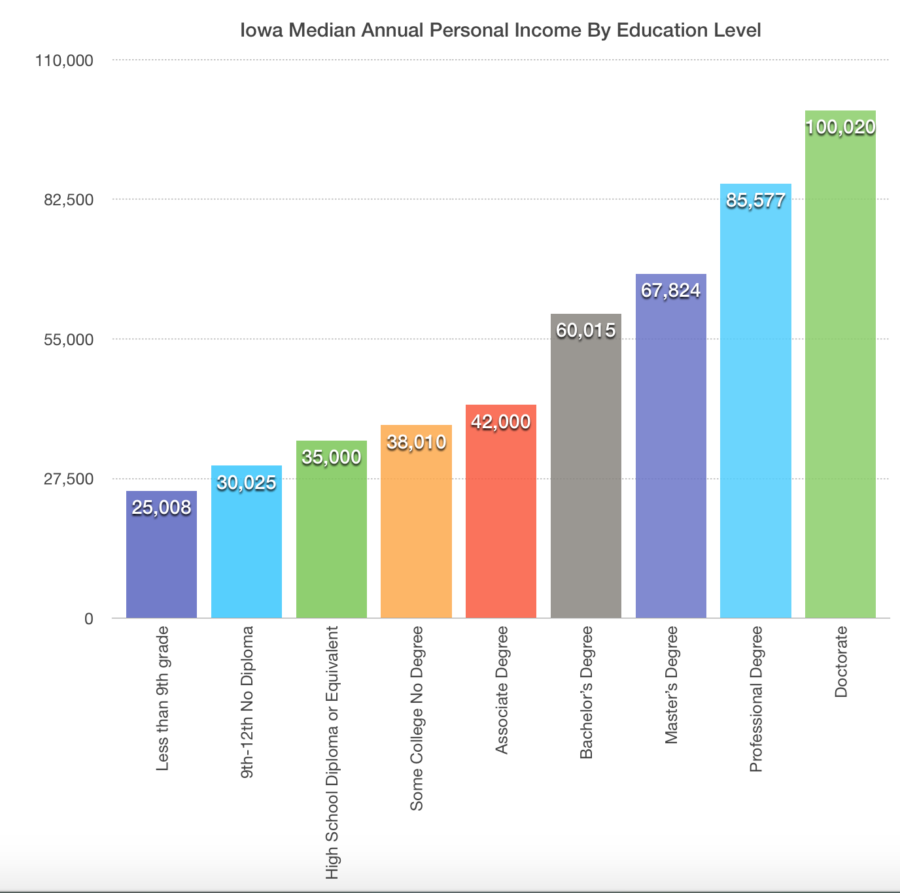Salo: Dear adult Iowans, it’s time to go back to school
This graph compares the difference in Iowan’s median income based on their education level. The data comes from the Bureau of Labor Statistics current population survey, 2014-2016 3-year average.
July 25, 2017
Last week, the Iowa Development Workforce sent out a press release to discuss the Metrics That Matter report that was released by the the Future Ready Iowa Alliance to discuss how to make Iowa more competitive in terms of education.
According to the report, the Lumina Foundation set a national goal for 60 percent of each state’s adult (ages 25-64) population to hold a degree or certification past high school by 2025.
The Future Ready Iowa initiative, which is led by Gov. Kim Reynolds among others, took that goal one step further and set Iowa’s goal at 70 percent.
Currently, only 58.1 percent of adult Iowans have a postsecondary degree or another form of certification. In order to reach the goal of 70 percent, 127,700 Iowans need to hit the books.
The report breaks the 127,700 into three categories of age groups:
Traditional aged students (18-24)
These students are currently either still in high school or are old enough to be enrolled in college. 41,200 in this category need to earn their degree by 2025.
Returning adult students (25-64 with some prior postsecondary education)
This category includes everyone who went to college or started on the path to earning certification in their field, but didn’t earn a degree or equivalent. Whether they’ve taken two credits or are two credits from a degree, they are included in this category. 35,200 in this category need to earn their degree by 2025.
Adult students (25-64) with no prior postsecondary education
The Iowans in this category didn’t go to college at all or didn’t even finish high school. 51,300 in this category need to earn their degree by 2025.
The two categories that we, as Iowans, need to focus on are the two categories of nontraditional aged students.
Reaching 41,200 degrees by 2025 won’t be an issue for traditional aged students, considering that at Iowa State alone, there were 36,600 students enrolled in 2016 with only 7 percent of those students being nontraditional aged (25 and older). That leaves 34,038 students graduating within four years, with the enrollment raising every year. That’s not even counting those graduating from University of Iowa, University of Northern Iowa and the 15 community colleges in Iowa.
There are currently 223,952 Iowans who have started, but haven’t completed college. Although this number may seem high, a Harvard study found that only 56 percent of students pursuing a four year undergraduate degree graduate within six years and of the students pursuing a two year degree, only 29 percent graduate within three years.
There are many reasons why students drop out of college – financial struggles, emotional or mental health issues, family drama, etc. No matter what the reason, it’s important for Iowans to receive a higher education.
The Metrics That Matter report shows that going back to college will not only make Iowa’s workforce more competitive and help the economy, it will also benefit each individual that goes back to receive a higher education as shown in this chart.
I understand that it may be hard for adults to go back to school if they are working and are trying to raise a family, but there are other ways to go to school than physically going to school.
As of June 2017, Iowa had 779 active registered apprenticeship programs across the state which are designed to let students “earn while they learn” in the fields that they want to go into. This is a great way for adult students to continue to support their families while also getting their education in order to earn more in the long run.
Many Iowa colleges also offer programs online in which students can start earning their degree from home.
However they do it, adult Iowans need to go back to school in order to make Iowa a more competitive, working state.







